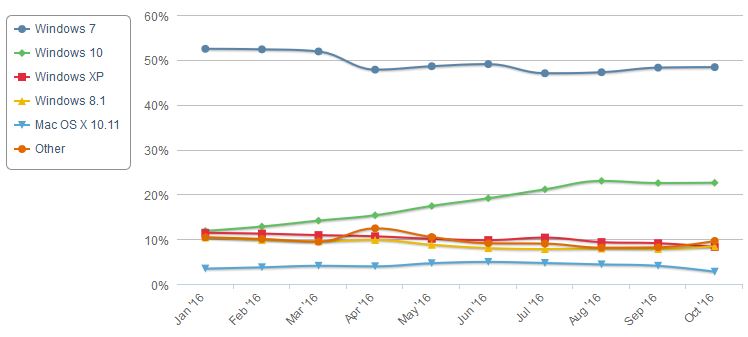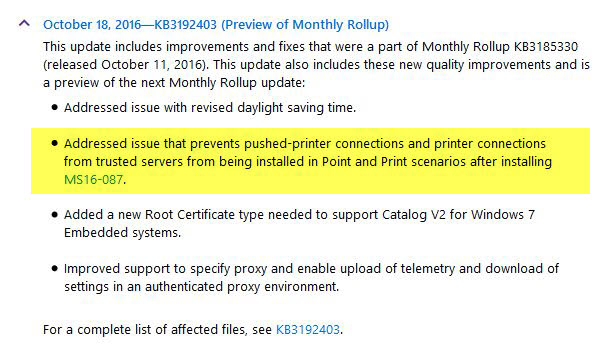-
The case for not updating Windows 7. Ever.
When I wrote in InfoWorld about the Windows 7 and 8.1 “patchocalypse” – last month’s abrupt change in the way Microsoft patches Win7 and 8.1 – I described two groups. I called them “Group A” and “Group B” (imaginative, eh?). In broad terms:
- Those in Group A are willing to take all of Microsoft’s new telemetry systems, along with potentially useful nonsecurity updates.
- Those in Group B don’t want any more snooping than absolutely necessary, and they don’t care about improvements like daylight saving time zone changes, but want to keep applying security patches.
I also described the hold-outs:
A third group, Group W, doesn’t want anything from Microsoft — no patches, no security updates, nada. I don’t recommend that you sit on the Group W bench, but it can be understood given changes Microsoft has made to Win7 and 8.1 machines, without our permission, in the past.
Since that time, I’ve written a lot of words about Group A and Group B. There are procedures, and nuances, for both. But I’ve generally avoided writing about Group W (named in homage to Arlo Guthrie; some people call it Group C). There’s a reason why.
I have a recurring nightmare – no, really – where somebody comes up with a really pernicious piece of malware that knocks out unpatched Win 7 and 8.1 machines, even when the owners of those machines are super-cautious. I’m talking about responsible Group W benchers who use alternative browsers (Firefox, Chrome), never click on anything that looks remotely dicey, and religiously run both antivirus programs and periodic antimalware scans.
I would never forgive myself for recommending a course of action that puts a big swath of Windows 7 users in harm’s way. After all, Windows 7 still accounts for about half of all PC use world-wide, and it’s likely to continue to be the dominant desktop operating system for years to come.
Source: NetMarketShare
I’m convinced that Group A (Monthly rollup) and Group B (Security-only updates) are viable alternatives, but there’s a lurking demon in the Group B closet. If we ever get a bad bug in a Security-only update, and that bug is fixed in a non-security Monthly rollup, all bets are off. If Microsoft breaks something in a Security-only patch, they need to fix it in a Security-only patch. Otherwise, those who only install Security-only patches are going to end up with bug-infested systems.
I’ve fretted over this problem in many of my InfoWorld blogs these past two months. In fact, we’ve already seen a minor example, where a Security-only update bug in MS16-087 was fixed in a non-security part of a Monthly rollup. Microsoft documents it here:
As best I can tell, that bug hasn’t been fixed in a Group B Security-only update. It may never be fixed in a Security-only update. That means someone who sticks to Group B and only installs Security-only updates will have the flaw in MS16-087 forever.
That’s simply inexcusable, even if the bug only affects a small number people in an esoteric way, even if Microsoft has documented complex manual fix instructions.
So we’re stuck between a rock and a hard place. On the one hand, Group B seems like an excellent approach for those who don’t want Microsoft’s Windows 7 snooping enhancements. On the other hand, if Microsoft can’t fix its own mistakes in Group B, there’s nothing you or I can do about it.
With that as background, I’ve asked Canadian Tech – who slogs through these problems with hundreds of users – to repeat a recommendation he’s made many times:
It now appears that B is an impractical strategy for 99% of users. And, here is the reason why: When an error is made in a security-only update, if the error turns out not to have a security affect, it may be corrected in a non-security update. In that case if you were following B strategy, you would be left with an un-corrected defective update installed on your computer. If you were extremely diligent and knew about it, you may be able to get the correction in specific cases. This would entail an extreme amount of diligence that few would be willing or able to provide.
The new rollup style of updates that Microsoft is now providing to what we would call Group A, which include all kinds of updates (security and non-security), are cumulative. That means if you miss a month or even more, it will not matter because by installing the latest month’s rollup, you would be up to date.
NOTE well, that Security-only updates are NOT cumulative. Which means if you miss a month, you may never get the missed updates.
So one strategy that you may wish to consider is following Group C, but still updating .net and Microsoft Office through Windows Update, but installing no Windows updates at all. It would be advisable in this case that you stop using Internet Explorer because you would not be getting those updates, but instead use an alternative browser.
Then, after following this strategy for some time, if things take a turn for the worse, and you decide you made the wrong choice (Group C with .net an Office updates), you can easily shift to A by simply using the latest offered Rollup offered in Windows Update.
So, as things have evolved, it looks like the vast majority have really only two choices: A as described above or C (modified as described above). The good news is that if you follow the modified C strategy, you have a way back to the Microsoft way, that is easy to implement.
There’s been an extensive discussion of Canadian Tech’s advice on the “Malwarebytes stumbles with false positive on KB 3197868, the Win7 November Monthly Rollup” post. Unfortunately, WordPress makes it very difficult to move comments from that post to this post, so I would ask those of you with strong opinions to please restate them (or copy and paste them) into the comments here.




